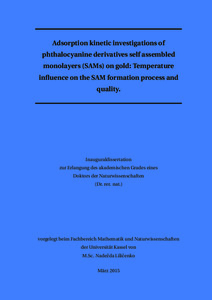| dc.date.accessioned | 2015-08-12T09:57:35Z | |
| dc.date.available | 2015-08-12T09:57:35Z | |
| dc.date.issued | 2015-08-12 | |
| dc.identifier.uri | urn:nbn:de:hebis:34-2015081248924 | |
| dc.identifier.uri | http://hdl.handle.net/123456789/2015081248924 | |
| dc.language.iso | eng | |
| dc.rights | Urheberrechtlich geschützt | |
| dc.rights.uri | https://rightsstatements.org/page/InC/1.0/ | |
| dc.subject | self assembled monolayers | eng |
| dc.subject | phthalocyanine derivatives | eng |
| dc.subject | adsorption kinetic | eng |
| dc.subject.ddc | 530 | |
| dc.title | Adsorption kinetic investigations of phthalocyanine derivatives self assembled monolayers (SAMs) on gold: Temperature influence on the SAM formation process and quality | eng |
| dc.type | Dissertation | |
| dcterms.abstract | The ordered nano-structured surfaces, like self-assembled monolayers (SAMs) are of a great scientific interest, due to the low cost, simplicity, and versatility of this method. SAMs found numerous of applications in molecular electronics, biochemistry and optical devices. Phthalocyanine (Pc) complexes are of particular interest for the SAM preparation. These molecules exhibit fascinating physical properties and are chemically and thermally stable. Moreover their complex structure is advantageous for the fabrication of switchable surfaces. In this work the adsorption process of Pcs derivatives, namely, subphthalocyanines (SubPcB) and terbium (2TbPc) sandwich complexes on gold has been investigated. The influence of the molecular concentration, chain length of peripheral groups, and temperature on the film formation process has been examined using a number of techniques. The SAMs formation process has been followed in situ and in real time by means of second harmonic generation (SHG) and surface plasmon resonance (SPR) spectroscopy. To investigate the quality of the SAMs prepared at different temperatures atomic force microscopy (AFM) and X-Ray photoelectron spectroscopy (XPS)measurements were performed.
Valuable information about SubPcB and 2TbPc adsorbtion process has been obtained in the frame of this work. The kinetic data, obtained with SHG and SPR, shows the best conformance with the first order Langmuir kinetic model. Comparing SHG and SPR results, it has been found, that the film formation occurs faster than the formation of chemical bonds. Such, the maximum amount of molecules on the surface is reached after 6 min for SubPcB and 30 min for 2TbPc. However, at this time the amount of formed chemicals bonds is only 10% and 40% for SubPcB and 2TbPc, respectively.
The most intriguing result, among others, was obtained at T = 2 °C, where the formation of the less dense SAMs have been detected with SHG.However, analyzing XPS and AFM data, it has been revealed, that there is the same amount of molecules on the surface at both temperature T = 2 °C, and T = 21 °C, but the amount of formed chemicals bond is different. At T = 2 °C molecules form aggregates, therefore many of available anchor groups stay unattached. | eng |
| dcterms.accessRights | open access | |
| dcterms.creator | Liličenko, Nadežda | |
| dc.contributor.corporatename | Kassel, Universität Kassel, Fachbereich Mathematik und Naturwissenschaften | |
| dc.contributor.referee | Hubenthal, Frank (PD Dr.) | |
| dc.contributor.referee | Siemeling, Ulrich (Prof. Dr.) | |
| dc.subject.pacs | 64.75.Yz | ger |
| dc.subject.pacs | 68.43.Mn | ger |
| dc.subject.swd | Gold | ger |
| dc.subject.swd | Monoschicht | ger |
| dc.subject.swd | Selbstorganisation | ger |
| dc.date.examination | 2015-06-03 | |

